Made with all purpose flour and just a touch of butter, learn how to make soft, tender sourdough sandwich bread with bubbly, active sourdough starter. So easy! Recipe adapted from my book: Artisan Sourdough Made Simple.
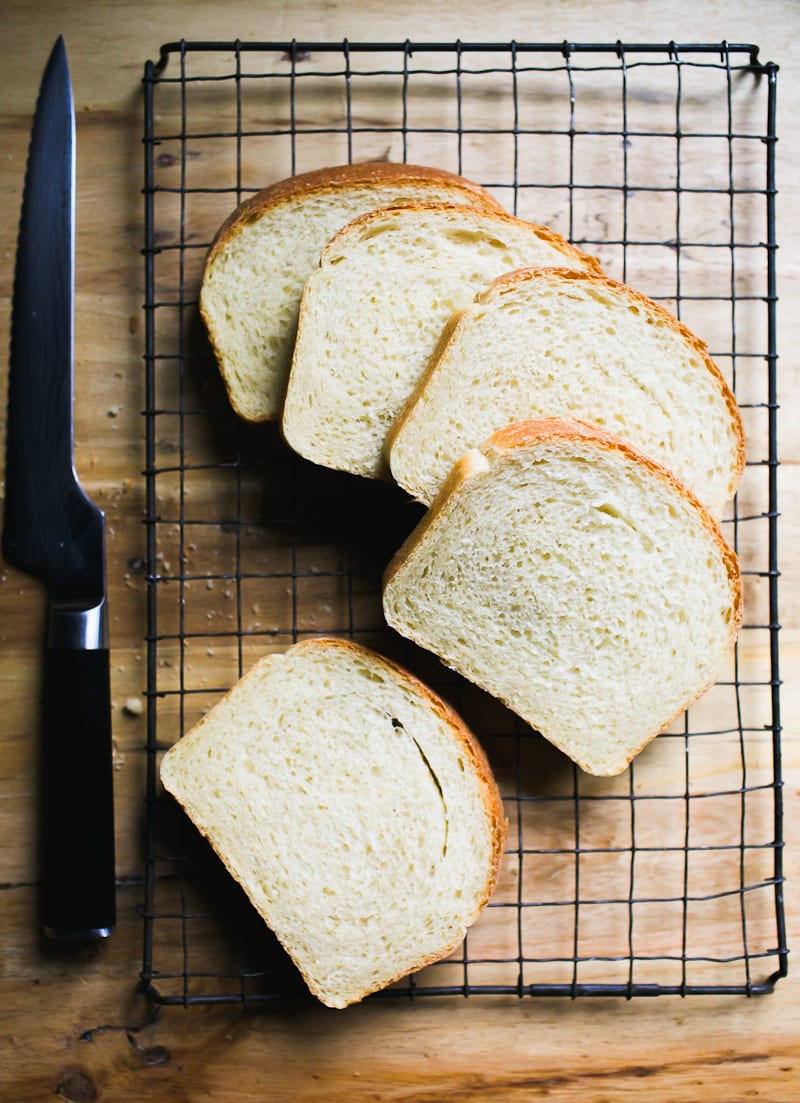
Out of the 4 classic sourdough bread recipes I make weekly (sourdough bread, sourdough focaccia and sourdough pancakes), sandwich bread is the most requested by far. Why? It’s soft. Buttery. It makes the whole kitchen smell like magic. And best part about making it yourself? It’s 100% natural.
There are no chemicals or nasty preservatives in homemade sourdough sandwich bread. Just hints of creamy butter with mild, tangy sourdough flavor in every bite. In this post, I’ll show you how make easy sourdough sandwich bread with step-by-step instructions and video. You’ll also find a sourdough cinnamon-raisin and whole wheat variation, plus more recipes in my bestselling book: Artisan Sourdough Made Simple. You’ll never go back to store-bought again!
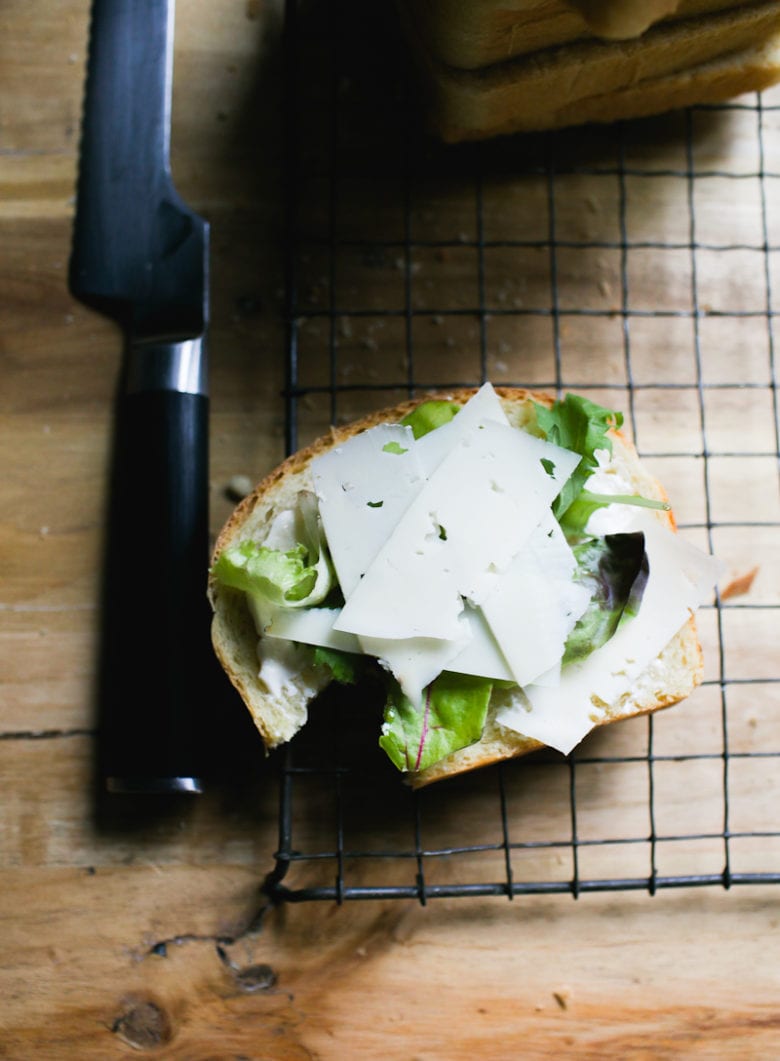
Sourdough Sandwich Bread: Ingredients & Equipment You Will Need:
- All purpose flour
- Unsalted butter
- Sugar
- Sea salt
- Sourdough starter
- Warm water
- Stand Mixer
- Loaf Pan
Recipe Tips
- No stand mixer? No problem! After mixing and resting the dough, knead by hand on a lightly floured surface for 8-10 minutes, or until smooth, soft and elastic. Do not worry about under/over kneading. This is very difficult to do by hand. Relax into the process and focus on the texture, not the time.
- Think about pan size. For a lofty-high rise, use an 8.5×4 inch loaf pan instead of the traditional 9×5 inch loaf pan. The smaller pan size will give the dough a boost. However, both sizes will work.
- Why Sugar? Enriched doughs, like this one, usually contain sugar (and butter, sometimes eggs). It adds just a hint of sweetness. This bread is not sweet. Omit if you want.
- Make it vegan. Replace the unsalted butter with your favorite plant-based, dairy free butter for a similar taste. Just watch the salt content though; some plant-based brands are very salty!
- Temperature controls time. The warmer it is, the faster the dough will rise. I’ve included helpful tips to boost the process. Full details in the recipe at the end of this post.
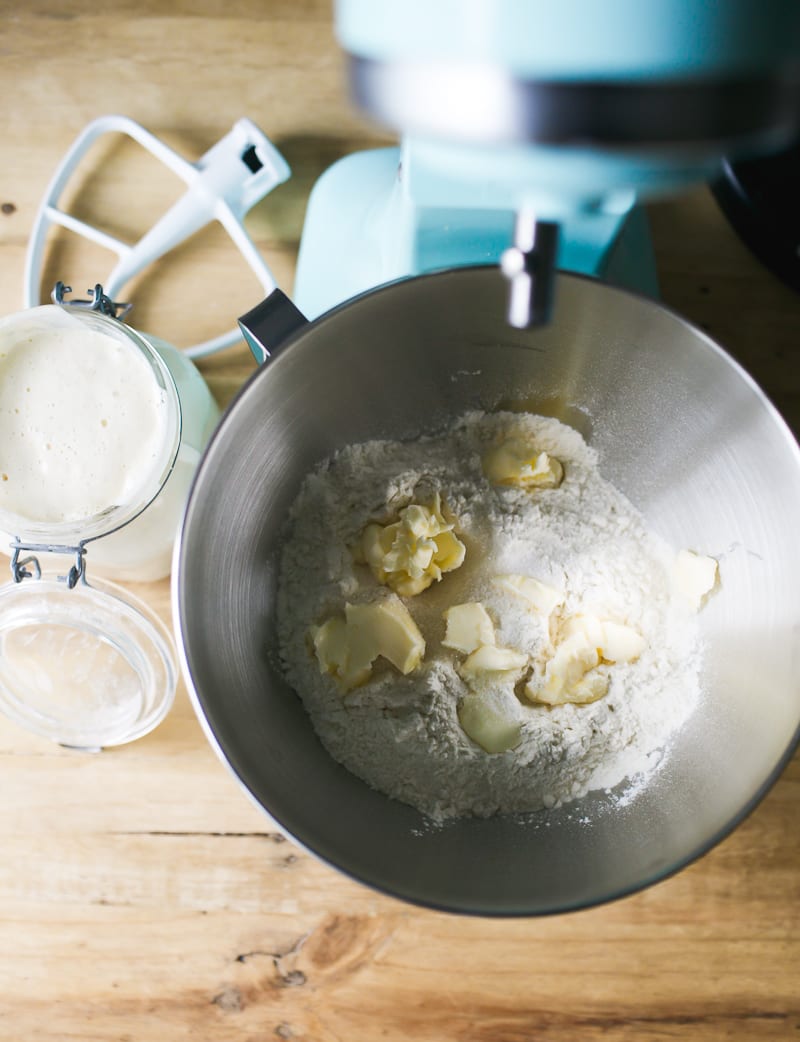
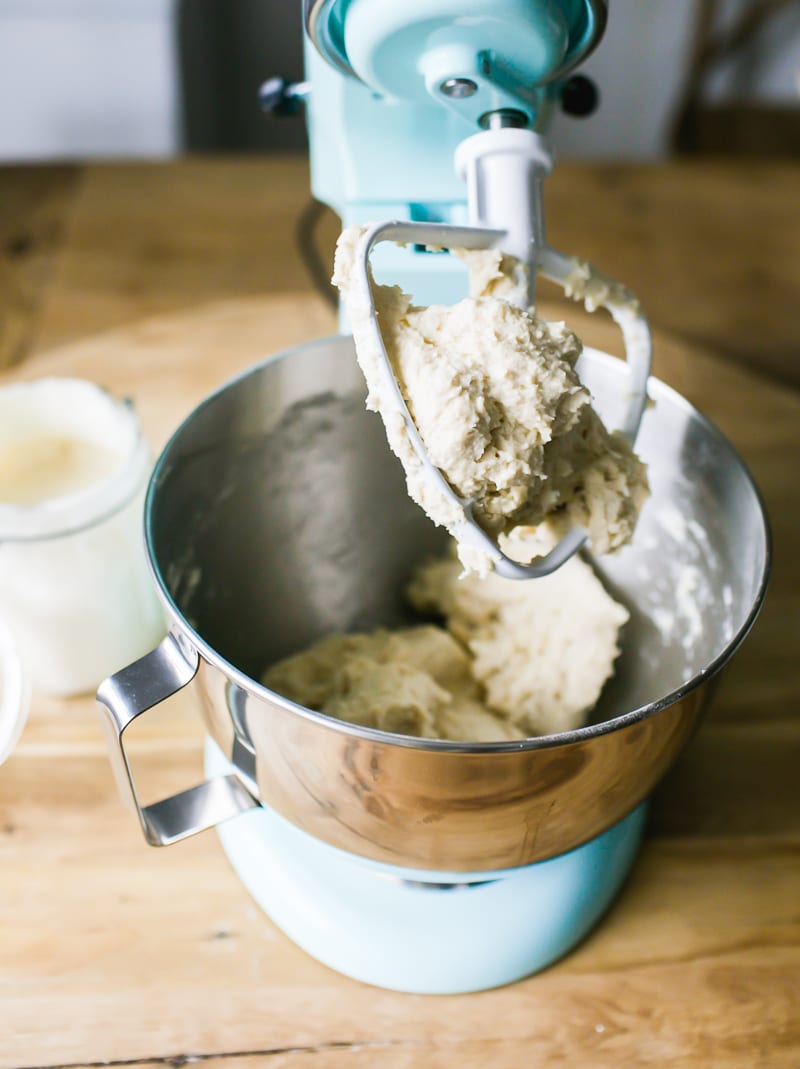
how To Make Sourdough Sandwich Bread
Mix the Dough
Weigh your ingredients using a scale. You’ll get better results doing so. In a stand mixer fitted with the paddle attachment: add the flour, butter, sugar and salt. Mix until the butter looks like crumbs.
Add the sourdough starter and water; mix again to combine. The dough will feel slightly sticky and elastic at this stage. Cover with plastic wrap or a damp kitchen towel and rest for 30 minutes- the gluten needs to relax.
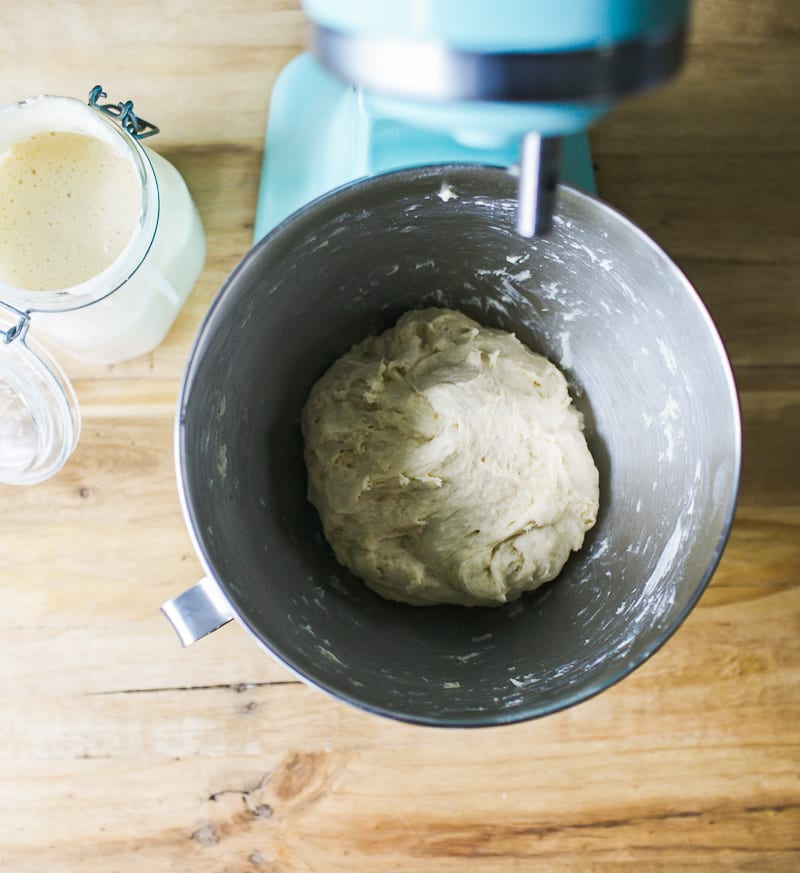
After the dough has rested…
Switch to the dough hook, and run the machine on medium low to knead the dough. This should take about 6-8 minutes or so. The dough should feel soft and supple, and not stick to your hands. On this particular day, my dough was a little bit stickier than usual so I added a dusting of flour to even it out.
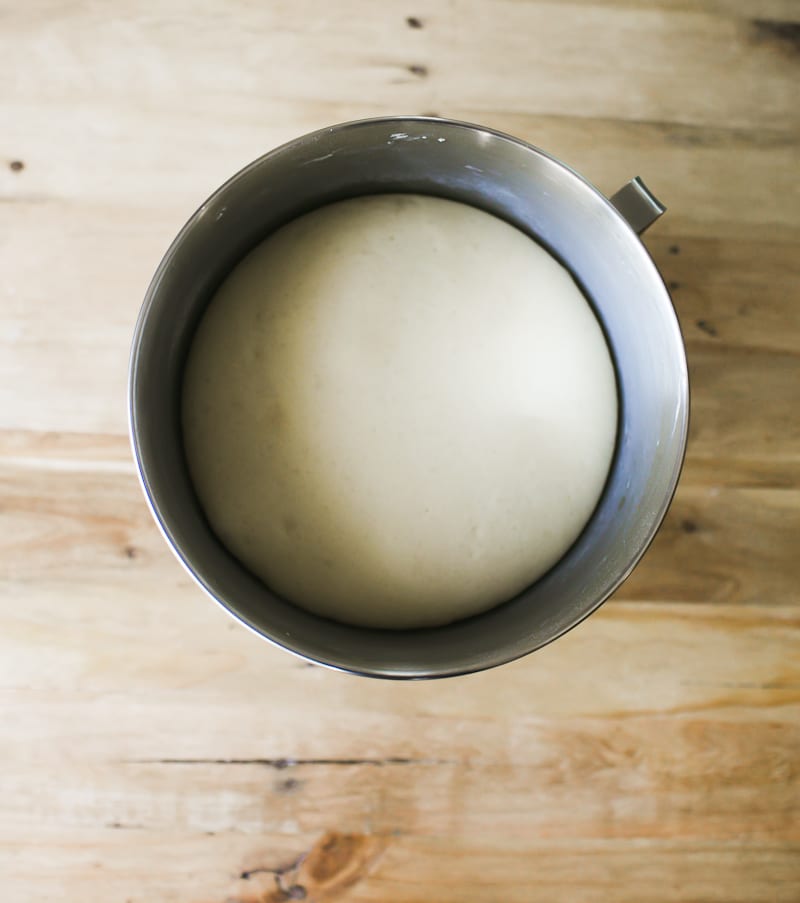
Bulk Rise
Cover the dough with plastic wrap or a damp towel. Let rise overnight at room temperature (68 F) for 10-12 hrs. The dough is ready when it has doubled in size.
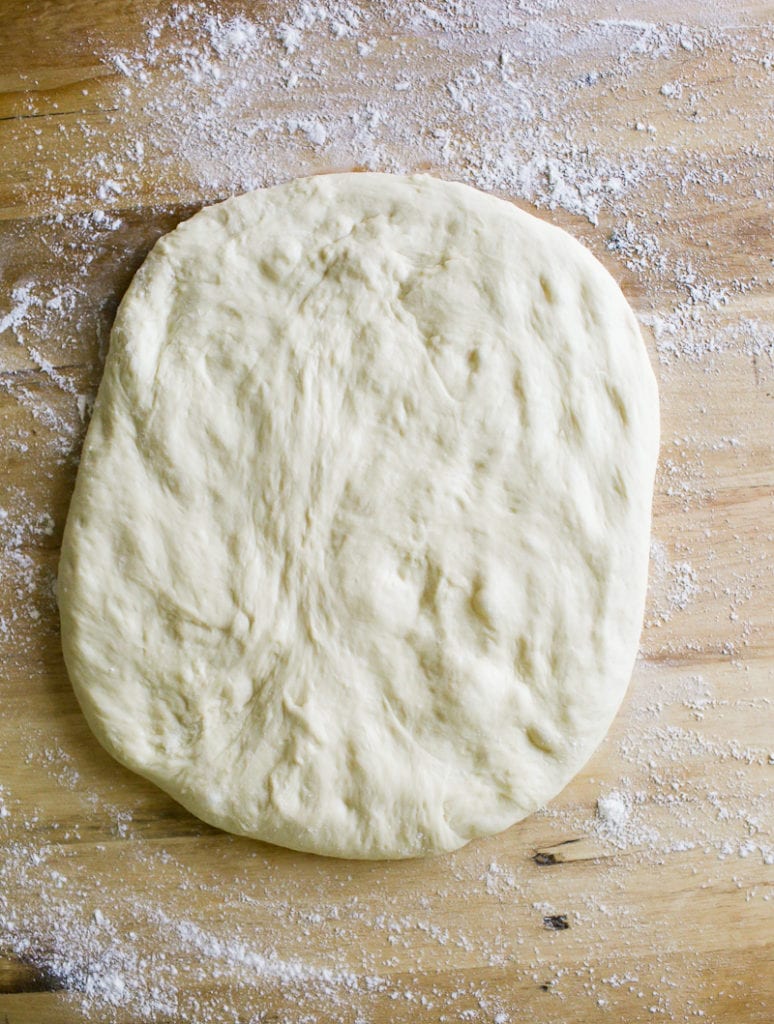
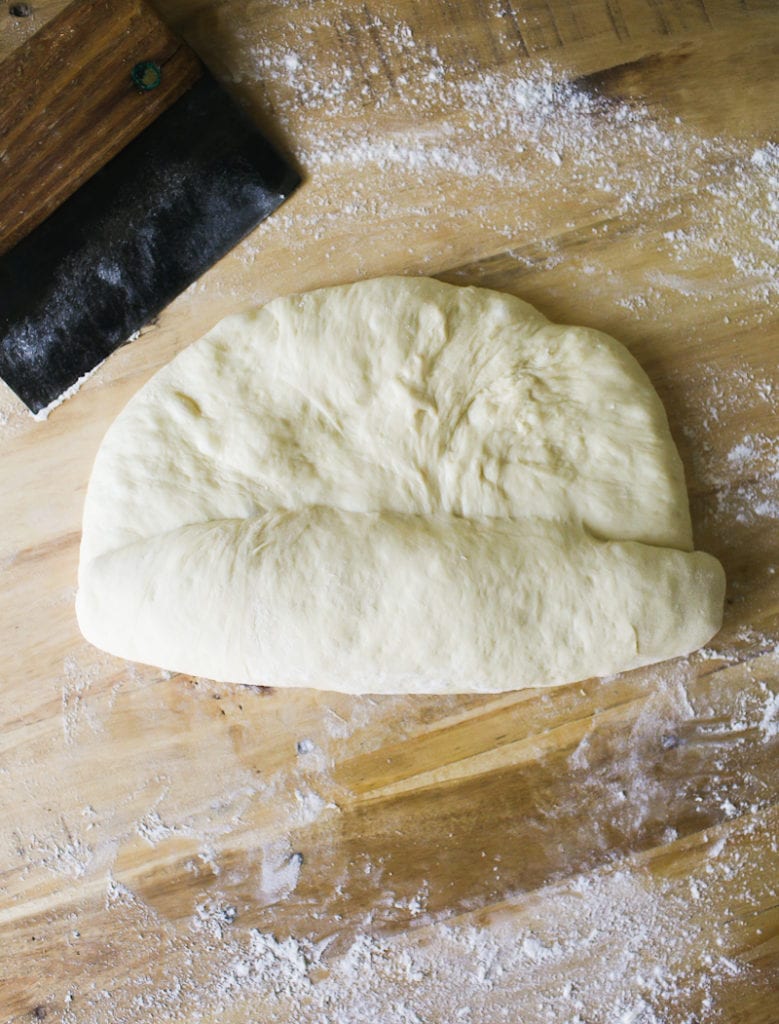
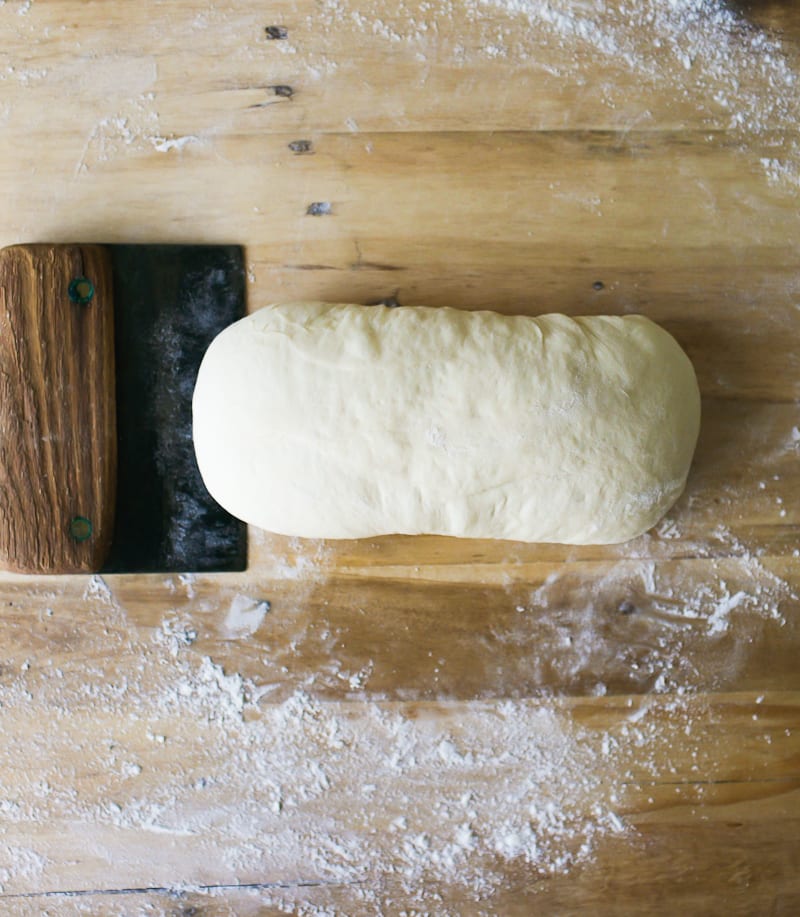

Shape the Dough
The following morning, coat a 8.5×4 inch loaf pan (or 9×5-inch pan) with softened butter.
Remove the dough onto a lightly floured surface. Gently flatten the surface to release some of the air bubbles. Sandwich bread should not have any large holes (unless you like jelly in your lap).
Starting at the bottom, roll the dough into a log tucking the ends underneath. Transfer to the loaf pan. Watch the Video!
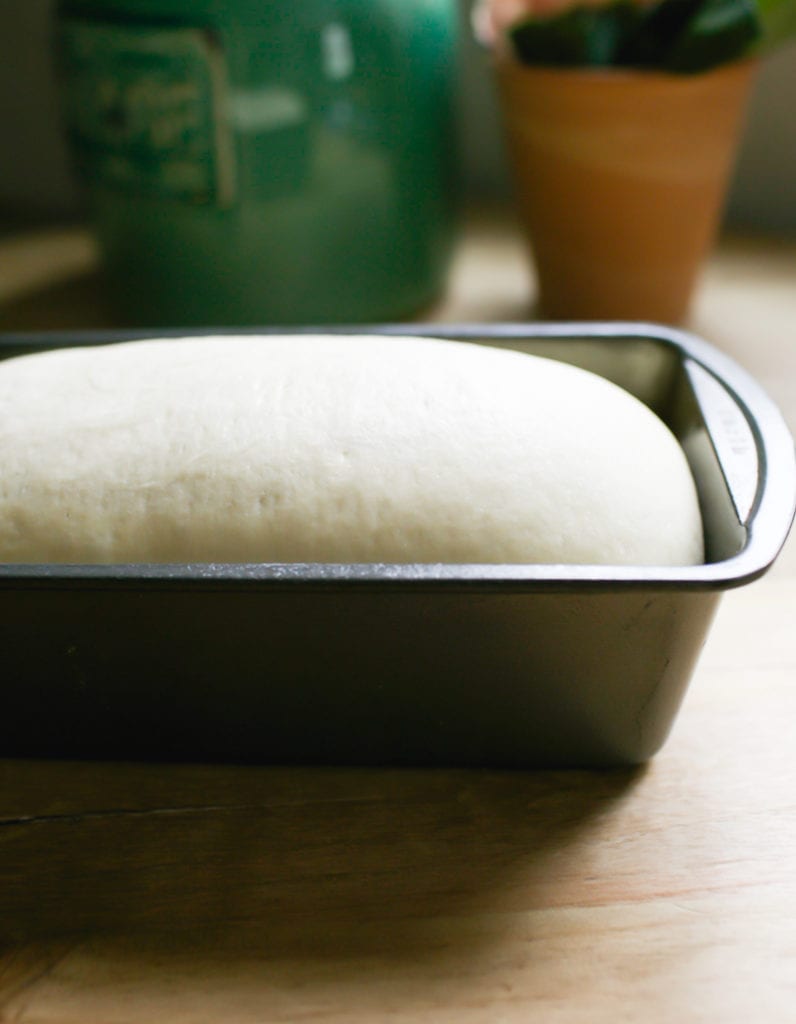
Second Rise
Now the dough needs to rise again.
This step is important because it builds back additional strength after the bulk rise. You’ll get a nice rise when it’s done correctly.
The dough is ready when the center rises to about 1-inch or more above the rim. It should look nice and puffy, and no longer dense. Be patient with this step. It takes time especially when the weather is cold. This is where the smaller 8.5×4 inch loaf pan comes in handy; the smaller size will speed of the rise. Consider using a proofing box to boost the rise.
Preheat your oven to 375 F.
TIP: For higher oven spring, preheat your oven to 500 F (instead of 375 F). Once the bread goes in, reduce the temperature to 375 F and bake as directed.
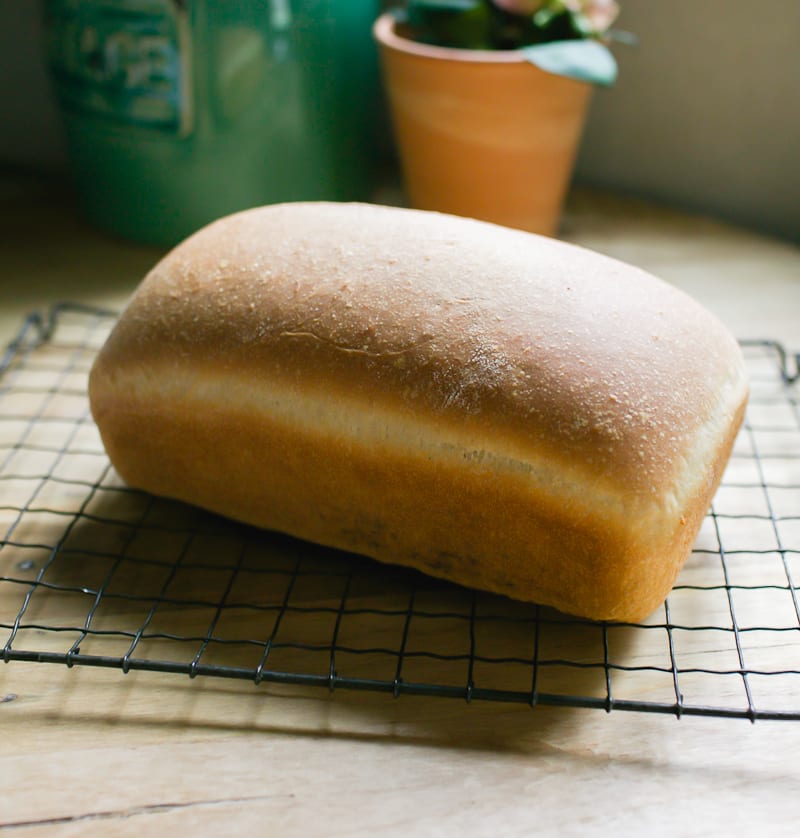
Bake the Dough
Place the dough on the center rack and bake for 45-50 minutes.
Once finished, let the loaf cool for at least an hour before your dive in. It’s worth the wait!
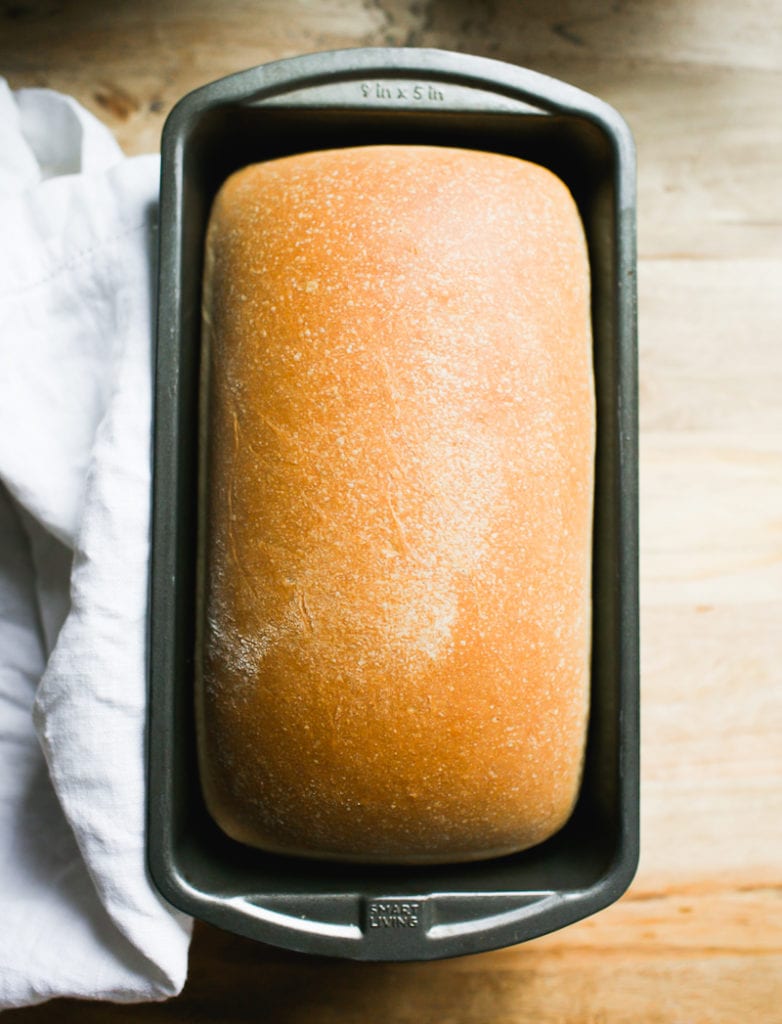
Additional Notes
If you have a large family, or just eat a lot of bread, I highly suggest doubling this recipe. Bake (2x) loaves side by side and freeze whatever you don’t eat. This loaf can be frozen whole, covered tightly in plastic wrap or as individual slices.
Sourdough Sandwich bread Variations
- Whole Wheat: Replace 20% all purpose flour with whole wheat or light whole wheat flour. If the dough seems dry (whole grain flours absorb more liquid), add more water as needed to achieve a workable consistency. Do this 1 tsp. at a time.
- Bread Flour: Do an even swap, adding more water if the dough is dry. For example, King Arthur Bread flour is very “thirsty” so more liquid might be needed. If using Gold Medal bread flour, which is not as absorbent, additional adjustments might not be necessary.
- Sourdough Cinnamon Raisin: Click here for my step-by-step post!
More Sourdough Bread Recipes To Try!
- Sourdough Focaccia Bread
- Sourdough Bread: A Beginner’s Guide
- Best Sourdough Pizza Crust (No steel or stone!)
- Easy Homemade Sourdough Bagels
- Light Whole Wheat Sourdough Bread

Easy Sourdough Sandwich Bread
- Prep Time: 12 hours
- Cook Time: 50 minutes
- Total Time: 12 hours 50 minutes
- Yield: 1 loaf
- Category: Sourdough Bread
- Method: Oven-Baked
- Cuisine: American
- Diet: Vegetarian
Description
A simple and easy recipe for homemade sourdough sandwich bread. Made with all purpose flour and just a touch of butter. I like to make the dough at night so we can have fresh bread in the morning. This loaf freezes well (whole or sliced). I recommend this loaf pan.
Notes
For best results, please weigh your ingredients with a scale instead of using measuring cups.
Here’s why: weight and volume measurements are not equal, only approximate! This is especially important regarding the sourdough starter. If your starter is very bubbly, 1/4 cup might only weigh 30 g which is too little for this recipe (you need 50 g). The dough will take forever to rise! Same goes for the flour… 4 cups might end up weighing way over 500 g depending on how tight the flour was packed into the cup. You’ll end up with dry dough.
I used Whole Foods 365 Everyday all purpose flour for this recipe. King Arthur and Trader Joe’s ap flour will work as well. If using another brand with a lower protein content (i.e. Gold Medal, Pillsbury, Heckers) consider reducing the total water amount by 15 g.
Ingredients
- 500 g (4 cups) all purpose flour
- 60 g (4 tbsp.) unsalted butter, softened, cut into cubes
- 12 g (1 tbsp.) sugar
- 9 g fine sea salt
- 50 g (1/4 cup) bubbly, active sourdough starter (100% hydration)**
- 270 g (1 cup + 2 tbsp) warm water
Helpful Tips:
** If the weather is not warm enough, sometimes the second rise can take longer than expected. To speed up the rise, use an 8.5×4 inch loaf pan (instead of a 9×5 inch pan), increase the amount of starter and decrease the amount of water for best results. Please choose one of the following adjustments below, keeping the rest of the ingredient quantities the same:
- 100 g starter + 255 g water
- 150 g starter + 250 g water
Additionally, because temperature controls time you can also increase your surrounding temperature for the bulk or second rise, as needed. Place the dough in a proofing box set to 75-80 F. Or, preheat your home oven to 75-80 F and then shut it off immediately (use an oven thermometer to make sure it’s set to exactly 80 F and not higher!). Place the covered dough inside until it bulks up. Do no use this option overnight- it will be too warm.
Instructions
Baking Schedule: this is an overnight dough which takes approximately 10-12 hrs to rise @ 68 F. Start the night before, in the evening, and plan to bake the following day. If it’s warmer than 68 F the dough will take less time to rise. Alternatively, start in the morning and bake in the afternoon or evening.
Mix the Dough
In a stand mixer fitted with the paddle attachment, add the flour, butter, sugar and salt. Mix on low speed until combined; the butter should look like crumbs.
Add the starter and warm water. Mix until the flour is fully absorbed (get in there with your hands to finish mixing). The dough will feel slightly sticky and elastic at this stage. Cover with plastic wrap or a damp towel and let rest for 30 minutes. Meanwhile, replenish you starter with fresh flour and water.
After the dough has rested, switch to the dough hook and run the machine on medium-low (#3 on a KitchenAid) for 6-8 minutes. The dough will feel soft and supple and not stick to your hands. If it does, add a dusting of flour.
Note: If you do not have a stand mixer, the dough can be made by hand. After mixing and resting for 30 minutes, knead the dough on a lightly floured surface for 8-10 minutes, or until smooth, soft and elastic. Do not worry about under/over kneading. Relax into the process and focus on the texture, not the time.
Bulk Rise
Cover the bowl with plastic wrap and let rise overnight at room temperature (68 F) until double in size, about 10-12 hrs. Please refer to the Baking Schedule above for additional rise time options.
Shape the Dough
In the morning, coat an 8.5×4 inch loaf pan with butter.
Remove the dough onto a lightly floured work surface. Gently flatten the surface to release any large air bubbles.
Roll the dough into a log tucking the ends underneath. Rest for 5-10 minutes. With floured hands, gently cup the dough and pull it toward you to tighten its shape. Using a bench knife, place the dough into the loaf pan seam side down.
Second Rise
Cover the dough with lightly oiled or buttered plastic wrap. Let rest at room temperature until it has risen to about 1-inch above the rim of the pan (check the height by looking at the domed center portion of the dough). You are not looking for it to double in size. For timing, this can take anywhere from 1 1/2-2 hours (or more!) depending on temperature and the amount of sourdough starter used. Remember, the warmer it is, the faster the dough will rise. Refer to the “helpful tips” at the top of this post.
Preheat your oven to 375 F. Note: For higher oven spring, preheat to 500 F instead. Reduce to 375 F once the dough goes into the oven and bake as directed.
Bake the Dough
Bake the dough on the center rack for about 45-50 minutes, or until golden brown.
Cool in the pan for at least 10 minutes, and then transfer to a rack to cool completely.
This sandwich loaf will stay fresh for up to 3 days, stored in a plastic bag at room temperature.
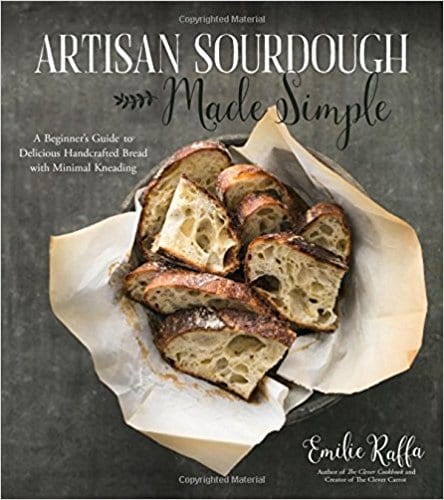


Comments
Amanda Hubert says
Help! I accidentally forgot about two loaves of this recipe during the shaped ride before baking. They were overproofed when I found them before heading out the door so I put them in the fridge. Is there anything I can do to salvage them or repurpose the dough? It’s hard to throw away 1000 grams of flour and all that time! So mad at myself for forgetting about them!
PS I really appreciate your website and recipes! We love your artisan loaves as well as your cinnamon raisin bread and cinnamon rolls!
Emilie Raffa says
Hi Amanda! Have you tried making focaccia? It’s perfect for overproofed dough- don’t throw it out. Off the top of my head: I would dump the dough onto an oiled, parchment lined sheet pan, or 9×13 inch pan, dimple the surface to stretch it out a bit, cover and rest until it plumps up. Then dimple the surface once more with oiled fingertips and bake for 30 min or so on a 425 F oven.
Amanda Hubert says
I had wondered about focaccia! Thank you! I’ll give it a try!
Brooke says
Do I preform stretch and folds at the start of the bulk rise?
Andrea says
No, you don’t need to do stretches and folds for this recipe.
Emilie Raffa says
Hi Brooke! You do not need to stretch and fold the dough in the recipe (the stand mixer takes care of the kneading). However, you are more than welcome to do so, if you prefer. One or two sets, in addition to the kneading time, is more than sufficient.
Elyssa says
Question! What about using a Pullman Bread pan that’s 9×13? How would the recipe or bake time be adjusted?
Emilie Raffa says
Ooo… this is a very good question. I haven’t tested it myself, so I’m unable to advise with specifics. However, if I experiment, I’ll update this thread. Out of curiosity, did you try it? Thanks!
Elyssa says
I haven’t yet tested it! If I do I’ll come back though. I figured the amount of dough for the larger pan may throw off the recipe and baking time significantly.
Andrea says
I’ve made this bread twice and cannot figure out what I’m doing wrong. I’m experienced in sourdough so I know what I’m doing. I weighed all of my ingredients. I did the second rise in my oven with the light on. After 6 hours it hadn’t doubled…maybe 50% increase but nowhere near the top edge. I go ahead and bake it and it tastes good but it’s dense, both times. Should I try more than 50g of starter? I really want to get this right!! I appreciate any tips.
Emilie Raffa says
Hi Andrea! First, try the increased starter option. Make sure it passes the float test to ensure it’s strong, vibrant and ready to use. Second, the dough does not need to double during the 2nd rise. I think that’s where the issue is. You can still do the 2nd rise in the oven with the light on (if the ambient temp. is cold), but decrease the overall time. It’s better to err on the side of slightly under proofed than over proofed, otherwise the loaf will lack oven spring.
Patty says
Hello Emilie, this sandwich bread is delicious! Ive made is several times and it came out perfect. Recently it would have been convenient to have an option to put in the frig. Is that possible with this recipe and if so, at what point can I do it? Thanks
Emilie Raffa says
Hi Patty! You have a few options: chill the dough once it’s almost doubled in size (and then give it more time to rise at room temperature if needed) OR chill the dough after you’ve shaped it in the pan. Keep in mind, for both options, the dough will be cold when ready to continue with the rest of the recipe. Extend your rise times as needed.
Dana says
My first rise went perfectly, and the second rise in the pan was almost done but I had to go to bed. I put it in the fridge overnight, and when I got up in the morning the dough had deflated. 😩 I am patiently waiting to see if it rises again, but I don’t have much hope. I will update later.
Clydia says
I love this bread recipe! It’s really simple and always turns out great. I was wondering if you have to bake in a loaf pan or can you shape it round and bake it in a dutch oven?
Emilie Raffa says
Hi Clydia! For sandwich bread, it’s best to use a loaf pan. But you can certainly shape it into a round loaf and bake in a Dutch oven. The style will change slightly, but it will still be very good!
Meghan says
I’ve been making this bread recipe for a couple months and my whole family loves it!
One question: Sometimes I am getting a big split in the side of the loaf after baking- what am I doing wrong? Thanks!
Emilie Raffa says
Hi Meghan! You’re not doing anything wrong. Most likely, the crust is forming too fast which hardens the surface and causes the loaf to split in certain spots. Adding steam to your oven will fix this. Drop a few ice cubes into a hot metal pan placed on the bottom rack of your oven. Add the dough and bake! Also: pay attention to your shaping. If its uneven, this will cause the loaf to split too.
Meghan says
Thank you! 💕💕💕
Emilie Raffa says
You’re very welcome!
alessia says
My family loves this bread! I am wondering if i can add seeds or change the flour ratios with rye or a grain blend? Thank you for sharing this!
Kimberly says
I wondering this too. Did you ever try it or find an answer? Thanks!
Emilie Raffa says
Hi Kimberly! Please see my comment below :)
Kimberly says
lol, HOW did I miss that (smack head emoji. maybe it was a jinx)? Thanks so much :)
Emilie Raffa says
Hi Alessia! To start, I would experiment with seeds, dried fruits and or nuts. The amount is really up to you, perhaps 1/2 cup. Soak them first in warm water, drain and dry thoroughly before adding to the dough (after the first rest). This way, they won’t soak up all of the dough’s moisture during baking. PS: Toasting nuts prior to soaking adds lovely flavor.
As for using different flours, it’s not as straightforward compared to adding seeds, due to the different protein contents and/or gluten levels. Most likely, you would need a new recipe, especially when working with rye flour- it does not contain as much gluten as regular wheat flour. You can find additional info and recipes in my book.
Patricia Turner says
I made this recipe yesterday…it was wonderful! A couple things…
1. Can I use bread flour?
2. Can I add nutritional yeast and seasonings such as Rosemary and/or garlic…etc.
I am a bit new to the sourdough scene….but have found that, although, I love artisan, the crust can be a bit tough. I will keep this recipe for sure! Thank you Clever Carrot!!!
Emilie Raffa says
Hi Patricia! Yes, bread flour will definitely work. Just watch your rise times as it contains more protein, which in most cases, encourages better gluten development. In other words: the dough might rise faster especially in warm weather! You can also add rosemary, garlic, and anything else you want to flavor the bread. Enjoy!
Lia McIntosh says
Fantastic recipe. The loaf was light, fluffy and delicious just perfect sandwich bread. The bread was so easy to make as well. I bought the book and can’t for it to arrive.
Emilie Raffa says
Thank you so much Lia! I’m thrilled to hear this. Enjoy the book :)
Sheila Marshall says
This recipe produced the perfect loaf of bread! I am amazed at how simple it was to make such a delicious homemade staple! I’ve tried many bread recipes and they never turned out quite right. But this one- once I got the sourdough starter figured out- is fast and easy. Gone in a day!
Made says
Store bought flour is void of nutrients, have you considered grinding your own to maintain the vitamins and minerals?
Amy says
Thanks so much for this lovely recipe. I have only been baking sourdough for a couple months but I can tell it’s going to be addicting. My family is spoiled for bread and this is the recipe I keep coming back to. My baking schedule is always a bit weird due to living in a very tropical climate but this recipe hasn’t failed. I keep sharing it with everyone I can.
Emilie Raffa says
You are very welcome, Amy! And thanks for sharing :)
Jocelyn says
Hi
After bulk ferment and shaping, can i pop it in the chiller and bring it out to bake the next day? Sorry 1st time attempting sourdough bread so I’m unsure. Thanks
Whitney says
I’ve done this once it’s shaped and in the loaf pan. I had started it in the morning, but not early enough so I didn’t have enough time to do the 2-hour 2nd rise and another 45-minute bake.
I put it in a plastic bag and seal it so it doesn’t dry out in the fridge. This basically slows down the second rise (also called a cold retard). When I take it out, I let it come to room temperature and finish it’s second rise (the step where you let it rise til it’s at least 1 inch above the rim) then bake. Worked great for me! Hope it works for you!
Whitney says
Hi! I’ve made this recipe many times (mostly to get a nice little arm workout kneading the dough by hand instead of in the stand mixer ha) but I’ve now gone through so much butter! Would you recommend an equal weight swap with olive oil?
Jessica Meyer says
Did you try this swap? I’m curious as well!
Whitney says
So, I ran out of butter at 30g haha so I replaced the rest with oil and it worked fine! I’ve also been greasing the pan with oil (since I have a spray version and it’s much easier than using the butter) and it doesn’t work as well getting the loaf out, but I just have to run a knife along the edge to coax it out.
Jessica Meyer says
Oh perfect! Thanks 😊 my kids are obsessed with this bread and I’m spending a small fortune on butter for it 😂 nice to know I can at least halve it
Whitney says
Update: I now use only olive oil in my sandwich bread and it still works great! I do the full 60g (I’m a little nervous to experiment with lowering the amount…) and just use my butter to grease the pan.
Teirrah says
The first time I tried this recipe my bread did not really rise and it was very dense but the second time I put it in the oven with the light on overnight to rise and it turned out perfect. I think my house wasn’t warm enough even though the thermostat is set to 68. Great sandwich bread and easy for a newbie like me.
Emilie Raffa says
Hi Teirrah! Yes: a warm environment is ideal for the dough to rise. Temperature is often overlooked in bread baking. But it’s a key “ingredient” so to speak. The warmer it is, the faster the dough will rise.
Shawna says
I was so excited about this recipe, but I somehow messed it up. I started the bulk rise at the wrong time of day, and ended up letting it rise for about 16 hours. It looked just like the above pics, but the dough was extremely sticky…too sticky to work into a log. So, I dusted with flour and made the log, put it in the pan, and it didn’t do the final rise. Do you think the long bulk rise is the culprit? Also, I ran out of AP and used bread flour…could that be the issue? It looked on track and rose beautifully…I just don’t know what I did wrong.
Emilie Raffa says
Hi Shawna! It sounds like the dough was over proofed (rose for too long). Oftentimes, over proofed dough is very sticky and then when you get the the second rise, it has exhausted all of its strength and doesn’t budge. Using bread flour instead of AP flour was not the issue. Next time, do the bulk rise for a little less time. Also: be sure to weigh your ingredients guarantee the correct amount of water is in the dough.
Barb says
For my starter is it 25g starter, 25 g water & 25g flour? Still new to sourdough. Thank you!
Emilie Raffa says
Hi Barb! That works. You are following the 1:1:1 ratio :)
Barb says
Thank you! Will be baking this week! Can’t wait to try!
Angela says
Hi Emilie! I have a question: why is it necessary to leave the bread in the pan to cool for at least ten minutes before removing? There is some discussion with me and my baker friends, and they asked my why I do that, and I replied, “Because Emilie says to do it!!”, but I’d really love to know the science behind it. By the way, I love your book and love your recipes! You have definitely simplified sourdough for me; all of your recipes are so easy to follow and turn out so well. You have helped me to become a very confident bread baker – thank you!
Emilie Raffa says
Hi Angela! Great question. It’s to “set” the crust. If you remove the bread from the pan too quickly, you’ll notice the crust is still really soft. About 10 minutes or more in the pan allows the crust to set, giving it more structure. Think of it this way: would you take a muffin out of its wrapper right out of the oven? No. You need to let it rest and let the moisture redistribute properly for best texture. It’s the same principle. PS: so glad to hear you love the book and recipes! This makes me so happy :) xx
Angela says
Thanks so much for your response! I am impressed that with all you do, you still take the time to individually respond to all of us. You are a gem!
Emilie Raffa says
Ahh, thank you Angela! xx
Mallory says
Just cut into my loaf, it’s incredible. Thank you so much for this recipe. My son will adore this.
Emilie Raffa says
You are very welcome, Mallory! xx
Marianne says
I put this together this morning. I went with the first option of less water, more starter because of the cool weather. It’s been sitting about nine hours now and it looks exactly the same as it did this morning. The dough was very sticky and it required more than a dusting of flour. My starter was active and passed the float test. The only thing I did wrong was I missed the part where you should use warm water. I used room temp which was about 72°. Is my dough in trouble?
Marianne says
I checked at 7:30 this morning and the dough looked great. It’s on the second rise now.
Marianne says
This bread was definitely worth the wait. I made a ham, Swiss and spicy brown mustard sandwich and it was just divine. Soft and just the perfect amount of tanginess. I think out of all (only 3, I’m a sourdough beginner) recipes I have tried, I will keep coming back to this one the most, with your beginner sourdough round loaf a close second. 👍👍
Mallory says
Mine didn’t rise much the first time either, but I risked it and did the second rise anyways and the second rise was perfect too!
Emilie Raffa says
Using warm water & a warm spot for the dough to rise will definitely help :)
Emilie Raffa says
Marianne, this sounds incredible. I’m telling you, sandwiches on homemade bread is absolutely out of this world! PS: I make two of these loaves at a time: one to eat and one to freeze!
Emilie Raffa says
Oh good! Excellent! xx
Emilie Raffa says
Hi Marianne! Yes: warm water is very helpful to boost the temperature of the dough. It will rise faster especially when the weather is cold. Next time, definitely use warm water in your initial dough mix (up to 95 F is fine) or if you forget, find a warm spot for the dough to continue to rise. It’s easy to correct midway through the process. Sometimes, I leave the dough in my oven, turned off, with the light on for an hour or two.
Marianne says
Thank you! I will definitely remember those tips next time around. 👍👍
Carol Flowers says
Hi Emilie
I have made the soft honey whole wheat loaf bread and the rise and loaves are beautiful. My only issue is when I cook at 375 for 40 minutes it is getting extremely brown on the top. I have used an oven thermometer and my temperature seems accurate. Thanks
By the way Love your book. Have purchased three and given as gifts.
Marianne says
Emilie, I have Artisan Sourdough Made Simple in my cart on Amazon but I would really appreciate seeing the table of contents before purchasing. My searches have turned up nothing. Can you help? Thanks.
Emilie Raffa says
Hi Marianne! If you click on the “Look Inside” feature, and scroll down, you’ll see the table of contents.
Marianne says
I looked for that feature but for some reason I couldn’t find it. I see it now. Thanks!
Emilie Raffa says
No worries :)
Sourdough Dan says
Without a doubt, the best bread this amateur has ever baked. Also, I am pretty sure the best bread this sourdough-phile has ever even tasted. If I could give 10 stars, I would.
Emilie Raffa says
Ahhh… Sourdough Dan, thank you SO much! Thrilled to hear you likeD the recipe :)
Kate says
Hi there!
Love this tutorial thank you!
Wondering: can this be frozen? Thanks!
Emilie Raffa says
Hi Kate! Absolutely. Once the loaf is completely cool, wrap in several layers of plastic wrap and freeze. Alternatively, cut the loaf into slices, separate with parchment paper, and store in a large ziptop bag. Defrost at room temperature. Reheat in a low oven or toast. Enjoy!
Alexis says
I have a 1lb loaf pan that’s like 13.5” by 5”, can I use it to make this recipe? Would I just need to double the recipe? Bake it for the same amount of time?
Emilie Raffa says
Hi Alexis! Hmm… I will be honest with you, I’m not exactly sure since I haven’t tested it myself! You could try doubling the recipe and bake it for the same amount of time (just keep an eye on the loaf). If you experiment, let me know how it goes ;)
Morgan says
Hello!
I’m pretty new to the sourdough world and am trying to understand how much starter I need to use to make 50 grams of the active sourdough starter at 100% hydration for this recipe. My understanding is that 100% hydration means equal parts flour, water and starter. Is that correct? If so, how much of each do I use for this recipe? Thank you for helping a novice sourdough baker!
Sara says
Could I use honey instead of sugar?
Emilie Raffa says
Hi Sara! Yes: honey is fine to use. You can either do an exact swap, or a reduced amount, perhaps 2 tsp. for a taste that’s less sweet.
Linda says
I have made this several times. The last time, i made 2 4×8 loaves because we don’t eat one loaf before it gets stale and they were perfect! I also put the loaves to rise overnight in the fridge because I was late starting it and then rose again for 3-4 hours. Perfect!
Emilie Raffa says
Sounds perfect, Linda! Doubling up is always a good idea ;)
Donna says
I made this sourdough sandwich bread with 25 g starter and 250g flour. I halved the recipe to make 1 loaf. The bread did not rise at all. I’ve been making sourdough bread for 2 years but this was my first time for sandwich bread. I suspect the amount of starter was too small. I followed this recipe carefully. What went wrong?
Emilie Raffa says
Hi Donna! Those quantities are too small for sandwich bread. I wouldn’t halve this recipe. For best results, I’d stick to the recipe as written, and perhaps freeze a portion of the bread if you’re after something smaller? Diving deeper: When sourdough doesn’t rise, it’s usually due to 3 things: temperature (not warm enough) the starter itself (not strong enough) + time (needs more). You need all 3 to be in synch for a successful rise. I don’t believe the reduced amount of starter was the issue.
Irongoddess says
Thanks so much for this wonderfully delicious and soft sandwich bread, and sooo easy to make! This will for sure become a staple in my home. You are right, it will be difficult to buy store-bought sandwich bread again.
Theresa says
The best bread ever!! Yummy. Came out perfect.
Raina says
I made this once already and had great sucess, thanks for the recipe! I would like to try it in my Pullman 4x4x10 pan with the lid, would all the directions still be the same?
karen says
This turned out fantastic on the first shot. The rising times were longer for me, but that’s normal for bread baking in December in Canada. Next up – the cinnamon raisin bread! Thx. ~ k!
Jordana says
Hi Emilie! I’ve used your recipes a lot before when I was in Florida (lower elevation), but now I’m living in Northern Arizona at 6,765 feet elevation. My dough hasn’t been rising as well and my bread falls when it bakes. Any tips I could use for baking at high elevation? I’ve been reading a few articles for regular baking, but I didn’t know what to do with sourdough baking.
Michelle says
Can I use whole wheat flour (or a mixture of all purpose and whole wheat) for this recipe?
Emilie Raffa says
Sure. I’d do a mix of both for best results. You might want to start with 15 % whole wheat and work your way up from there, depending on the flavor profile and texture you’re looking for.
Jenny Webb says
Fantastic! It turned out exactly as pictured and was easy to make and required much less time than the standard round loaf. No stretching/folding, no refrigeration or dutch oven required.
Emilie Raffa says
Thanks Jenny! xx
Deanna says
Hi! I made the dough last night and let it sit out. It has been almost 11 hours and it has not doubled. Should I put it in a warmer place and see if that helps? Or is it a complete loss? My starter was very bubbly before but it is my first time.
Emilie Raffa says
Hi Deanna! Yes. Your dough needs a warmer spot to rise. If your starter is strong and active, then temperature is usually the culprit. Warm spots include a proofing box set to 75-78 F or in your oven (turned off) with the light on for a short period of time (it gets hot in there). Also: next time use warmer water in your initial dough mix, about 90-95 F.
Jordan says
Great recipe, I can’t wait to try it this weekend. Do you have an estimate of how long the second rise typically takes? I’m trying to decide if I should prep it for the second rise in the morning and run errands or if the time is super short, I can wait until after my errands. This is my first time making sourdough anything or bread! Thank you!
Zelda Dancer says
We are really enjoying this recipe! We named it Emilie’s Easy Sourdough Sandwich Bread! Been doing sourdough over a year now, and like to try different things. This is wonderful for sandwiches, and survives the toaster very well. Tender and delicious with the sourdough tang and a fun change from the toothsome standard sourdough loaves. Thank you for sharing.
We tried doubling the recipe because we chowed down the first loaf so quickly, but it was too much for the stand mixer. Every other part worked well, just had to divide the dough for the step with the dough hook after the 30 minute rest. We also added a piece of plastic wrap with a spritz of cooking spray touching the top of the dough while it is doing the bulk ferment, and again on top of the loaves rising in the pan to prevent it drying out and forming a hard skin.
Stacia says
I just made this today and your cranberry pecan sandwich loaf last week. I can’t seem to get the sides to brown like I see yours does. I baked it for a full 50 minutes too. I even removed the loaf from the pan immediately and put it back inthe oven for an extra five minutes. It didn’t brown too much but I didn’t dare put it in for longer as I was worried I might overcook the bread. Any tips?
Also would adding milk make the loaf fluffier? How would you suggest I adjust the amount of water if adding milk?
Emilie Raffa says
Hi Stacia! Very interesting. Do you have an oven thermometer? The first step is to make sure your oven temp. is accurate. The second thing that comes to mind is dough fermentation. Usually, if the dough doesn’t brown it can be under proofed. Did your loaf double in size during the bulk? And how long was the second rise? Milk will make the dough slightly fluffier (butter helps too). I haven’t tested exact amounts, but try doing 50/50 and see how that goes.
Stacia says
No I dont have an oven thermometer. Its just the sides that don’t brown.. the top part browns nicely. Would the material of the loaf pan have anything to do with it? Anyway I might try again but using a pullman tin to see how that turns out.
As its hot where I live so I only bulked it for about 4.5 hours before shaping and letting it rise again in the pan for about an hour. When I pressed on the dough.. it didn’t bounce back immediately and in fact it didn’t rise up slowly either so I popped it in the oven right away.
Will give it a go again with milk. Do you happen to have a wholewheat sandwich recipe too?
Kristen Topliff says
This is far and away my very favorite sourdough recipe. And everyone in the family loves the soft texture when some of my other sourdough creations are not a hit. The instructions are clear and easy to follow, great for beginners!
Novice Cook and Baker! says
Hi Emilie, I plan to try this recipe today/tomorrow. I only have an 8.5 x 4.5 loaf pan. Should I decrease the recipe slightly or do you think I can make it work? Thanks in advance!
Emilie Raffa says
Hello! The 8.5 x 4.5 loaf pan will work. I have one at home that I use all the time with great results (and higher rise!).
Novice Cook and Baker! says
I baked this today and it turned out beautifully!! How do you think it would it turn out without adding in any butter?
Thank you so much for the awesome recipe.
Jeannie says
Hi, I love this recipe, and I’m wondering if I could use a pullman loaf pan? It is 4 1/2“ x 8“ but it is taller than a normal oaf pan and has a lid? Thanks!
Emilie Raffa says
Hi Jeannie! Great question. Unfortunately, I haven’t tested it myself so I’m unable to report back with specifics and/or adjustments. However, if you experiment, please let us know.
Jeannie says
Ok. Thanks. I’d be happy to let you know after I try it. Jeannie
Anna says
Hi this recipe sounds great however one question from my side – how come you don’t need to worry about creating a moist environment for this loaf n you just bake it uncovered? I thought it was necessary to cover it or add steam for a better oven spring. How does it work then ?
Mitch says
You don’t need to cover it unless your going for block loaf shape. The moist environment is trying to create that thin crisp skin on an artisan loaf, that’s not so important with a sandwich loaf.
The extra moisture also helps gain the more open texture that you see from traditional artisan sourdough, again, not needed for a sandwich loaf.
Anna says
That makes sense, thank you for your reply !
Sarah Pow says
Oh. My. GOODNESS. I feel like I just met my long lost love! This is easy to make and so amazing. Flavor, texture, perfect!
Christine Williams says
I love your Artisan Sourdough book and now branching out beyond Everyday Sourdough. How would this sandwich bread recipe change if olive oil were used instead of butter?
Lauren Troyer says
Love this recipe! It is my favorite and I have to keep it on hand. I was wondering if anyone has tried to replace the sugar with honey. Did you need to cut back on water?
Rachel Morrison says
Followed this recipe to the T and it came out fantastic! My first time ever making bread!! Thank you so much for your tips on the starter and your explanations of what the dough should look and feel like, helped so much!! Omnomnomnom!
Debbie Van Horn says
This is, hands down, the best sourdough bread recipe ever. Soft and sturdy – just perfect for sandwiches. I’ve made it several times and it never disappoints. I add about 1/4 teaspoon of citric acid for a little extra sour kick and have noticed that it lasts a day or two longer with the addition (if we don’t finish the loaf straight out of the oven).